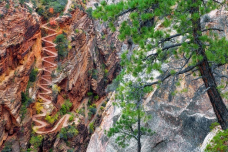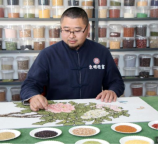1 . 
Zion National Park in Utah has plenty of trails, but Angels Landing may be the most breathtaking. Picture this. You begin the hike on the wide and well-maintained West Rim Trail. It follows the river and then crosses the bottom of the canyon, surrounded by 270-million-year-old layers of rock. Relaxing, right? Just wait for it. The trail then starts to climb via a series of switchbacks (急转弯) leading up the side of the mountain. Then more switchbacks: 21 tighter turns, called “Walter’s Wiggles,” where elevation levels rapidly increase. Your heartbeat is probably rapidly increasing at this point, too.
On top of Walter’s Wiggles, you can stop for a stunning view (perhaps with a marriage proposal) and a restroom stop while you contemplate (仔细考虑) the final stretch of the hike. If you’re afraid of heights, it’s best to turn back now. The last stretch is the real test of bravery.
The last half mile of the hike is what really ranks it as one of the nation’s most dangerous. Angels Landing itself is a fin-like formation jutting (突出) 1,500 feet out of the canyon, and this is where you make the final 500-foot climb. Guardrails and chains bolted (拴住) into the cliff help you keep from tumbling over the extremely steep ledge. You’re literally living on the edge, and you don’t want to trust the “angels” down there to catch you. Once you reach the top, however, it’ll all be worth it: 360-degree views of the canyon make a great backdrop for kicking back and having a meal before you come back down the way you came.
Angels Landing might be dangerous, but thankfully, not too many people have had fatal falls. According to the park website, seven people have died in the 100 years the park has existed. Still, this is a very vigorous hike. If you’re out of shape, bringing young children along, feel ill or prone to fainting, or are just plain afraid of heights, opt for an easier trail.
Angel’s Landing is a great hike for most of the year, besides the cold winter months when the trails could become dangerously slippery. Summer is the most popular time of year — and therefore the most crowded — but it can also get extremely hot, so opt for an early morning hike while the temperatures are still mild.
Sure, it’s dangerous, but there’s a reason this is one of Zion ‘s most popular hikes. If you’re up for the challenge, Angels Landing will definitely deliver rewards.
This article first appeared on Curiosity.com.
1. What geological feature surrounds the hiker during the initial part of the hike?| A.Plenty of trails in the park. | B.Mountain Peaks. |
| C.270-million-year-old layers of rock. | D.Grass Meadows. |
| A.The challenging hike with switchbacks. |
| B.The 360-degree views of the canyon. |
| C.The well-maintained West Rim Trail. |
| D.The river crossing and rock formations. |
| A.If a tourist is afraid of heights, it’s best to turn back onto Angels Landing. |
| B.Seven people have died so far due to slippery trails in winter. |
| C.Bringing young kids along to climb onto Angels Landing will be appreciated. |
| D.Taking a break with the views of the canyon as background is absolutely worth the trip. |
| A.Unveiling the Hidden Beauty: Exploring Zion National Park’s Trails |
| B.Zion’s Ultimate Thrill: The Adrenaline-Pumping Angels Landing Expedition |
| C.Chasing Heights: Angels Landing Adventure in Utah’s Zion National Park |
| D.Angels Landing: Conquering Utah’s Breathtaking and Daring Hike in Zion National Park |

Han Guorui, a folk artist specializing in making Dongming grain pictures, is generally busy in autumn as he needs to collect materials for his work. This year, he has been even busier, as he has attended fairs to demonstrate his skills and promote grain art.
The grain pictures, which take their name from Dongming county in Heze, Shandong province, are a traditional folk craft with a history of more than 200 years. The practice was listed as a provincial intangible cultural heritage(非物质文化遗产) in 2016 by the Shandong Provincial Department of Culture and Tourism.
After being treated to prevent decay and insect infestation, grains, grass and vegetable seeds are glued together to form a picture.
“We use the different shapes and colors of grains and seeds, which are all collected from the field,” says Han.
Born in Dongming, a county along the banks of the Yellow River, he attended a regional fair in mid-October. His pictures attracted many children who asked questions, such as, “will these seeds sprout”, and “can these grains be eaten?”
Han answered the children’s questions while showing them how to use grains and seeds to make a picture.
“Only now, when food is sufficient, can people make a picture with surplus grain,” he says.
To make pictures that more people like, Han works in the style of Chinese ink and Western oil paintings. Now his grain pictures are not only sold in cities across China, but also to overseas markets, including some European countries, South Korea and Japan, he says.
“Grain pictures have become a cultural product that is helping to enrich farmers living on the Yellow River plain,” says Han.
The Yellow River, the country’s second longest, is considered the cradle of Chinese civilization. For thousands of years, the people living along its banks have nurtured rich and vibrant cultures that have endured to this day.
To give people the opportunity to familiarize themselves with its rich culture and plentiful products, Shandong province has organized fairs named after the river throughout the year, with some events held in communities to involve more people.
At the fairs, intangible cultural heritage items, handicrafts, local delicacies, performances, and agricultural products are available.
At one fair in a community in Jinan, the capital city of Shandong, in late October, more than 10 types of handicrafts were on show, including gourd-carving, paper-cutting, textiles and hemp rope weaving.
“The fair builds a bridge between intangible cultural heritage producers and consumers. Using items that are embodied with traditional culture is a good way to pass on culture,” says Sun Xicai, deputy director of Jinan Folk Literature and Art Association.
At the fair, 60-something Yu Shaoqing, who was selling animal-shaped textile products, attracted a lot of buyers.
“Many young people show an interest in my products. They buy them to decorate their rooms and cars,” says Yu.
Yu, who worked in embroidery design before retiring, designs her products, which take the shape of animals like tigers, rabbits and ducks. Currently, she is working on a dragon design for next year to welcome the Year of the Dragon.
1. What do the grains undergo before being used in the artwork?| A.Grains are carefully selected, painted in various colors and air-dried. |
| B.Grains and seeds are bonded following certain preservative treatment. |
| C.Grains and seeds are well preserved so that they will spout. |
| D.Grains are carved and then assembled into a picture. |
| A.due to advancements in technology |
| B.because of nurtured rich and vibrant cultures along the Yellow River |
| C.in situations where there is a sufficient and excessive supply of grains |
| D.as a result of government’s financial supports for local artists |
| A.Electronics and fashion items; performances showcasing modern technology |
| B.Handicrafts, local delicacies, performances, and items embodied with traditional culture |
| C.Industrial machinery and tools; demonstrations of manufacturing processes |
| D.Luxury goods and designer fashion; fashion shows featuring international designers |
| A. attraction B. waiting C. mystery D. unique E. simply F. originally G. stable H. popularity I. donating J. searching K. interfere |
There’s a rarely-visited, dusty corner of the world where something magical happens. The place, which looks like Mars with its red rock landscape, is the Tatacoa Desert, in Colombia.
Tatacoa is located in the region of Huila, south of the country’s capital Bogotá. Although Tatacoa, with its protruding cacti and red rippled rocks, is called a desert, it is in fact a dry tropical forest. But the exciting, and very
Thanks to its remote location — it’s almost 30 miles and an hour’s drive over bumpy winding roads to the nearest town — Tatacoa has no light pollution to
Up to 88 constellations (星座) are visible on a clear night, as well as both hemispheres — something that happens nowhere else in the world.
The warm and dry climate helps with stargazing; a
Not only is Tatacoa a natural wonder, but the DIY observatory that’s run by a Colombian man named Javier Fernanda Rua Restrepo has become a star
The Colombian, who is
At first Restrepo had worked at the Colombian government’s observatory, which he helped staff for 15 years. But after budget cuts meant he lost his job, he figured he would
In 2015, Restrepo opened the doors to his observatory — Tatacoa Astronomia — with just one telescope. Now, as Colombia has grown in
Tatacoa Astronomia is only open on starry nights, and Restrepo remains the sole employee. But that doesn’t distract from the intimacy and the specialness of the place. The structure sits on a small patch of land that Restrepo bought himself, and is cordoned (隔离) off by tarpaulin (油布) to add an extra sense of
“The stars… they put my life into its tiny perspective,” he says, “and they constantly remind me there are greater things out there.”
| A.Rainy days. | B.Sunny days. | C.Cloudy days. | D.Snowy days. |
| A.Graduated. | B.Got married. | C.Bought a house. | D.Got promoted. |
| A.Once a day | B.Twice a day | C.Three times a day | D.Every other day |
| A.To improve digestion. |
| B.To prevent bad breath. |
| C.To enhance tooth surface. |
| D.To reduce the risk of decayed tooth. |
| A.Early detection of issues. |
| B.Emergency tooth extraction. |
| C.Teeth whitening procedures. |
| D.Improving gum health. |
| A.Keep all copies in hotel safe for important documents |
| B.Make copies and leave one set with someone back home |
| C.Don’t make copies to avoid misplacement |
| D.Share copies with fellow travelers |
| A.Use local SIM cards so as to get touch with family quickly |
| B.Check in only when changing countries |
| C.Use messaging apps and a local SIM card for emergencies |
| D.Avoid communication to focus on the trip |
| A.Always carry large amounts of cash |
| B.Use RFID-blocking wallets and backpacks |
| C.Avoid crowded areas entirely |
| D.Trust strangers to watch your belongings |
| A.Avoid vaccinations and bring your own food for health purpose. |
| B.Eat and drink anything available, especially those with local flavors. |
| C.Explore information on vaccinations and health guidelines. |
| D.Don’t worry about staying thirsty. |
1.
| A.Cooking at home with the help of family |
| B.Quick and convenient access to favorite meals |
| C.Dining out regularly so as to have balanced nutrition |
| D.Avoiding all junk food which only tastes nice |
| A.Slow preparation and nice cooking. |
| B.Accurate delivery time estimates. |
| C.Quick preparation and delivery. |
| D.Unlimited menu options to be confusing. |
| A.Limited choices. |
| B.Providing various tastes and preferences. |
| C.Only offering pizza and burgers. |
| D.Exclusively featuring local foods. |
| A.Improving health | B.Building muscle | C.Flexibility | D.Weight loss |
10 .
| A.Entertainment only | B.Medical purposes | C.Education and training | D.Virtual tourism |



